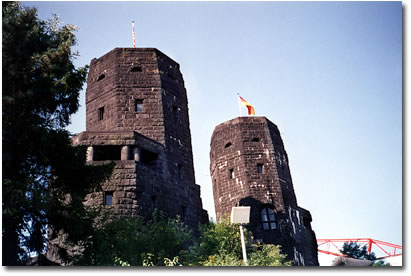|
|
|
|
|
|
 |
 |
|
|
| 9th
Infantry Division — World
War II — Remagen, Germany |
|
|
|
 |
 |
 |
 |
 |
 |
 |
|
The
twin tower remains of the
railway bridge known as the
Ludendorff Bridge at Remagen,
Germany. The Ludendorff Bridge
today hosts flags for both
the United States of America
and Germany.
|
STORY FROM
EIGHT STARS TO VICTORY CONTINUED:
"Remagen is situated at the base
of Victoriaberg Mountain on the western
bank of the Rhine River. It is a town
of approximately 5,800 population
(in 1945) and was founded in the dynasty
of Tiberius, the Roman. Crumbling
Roman walls and gate still stand (in
1945), and at that time these ruins
seemed in strange contrast with the
railroad line which carried trains
up from the south.
"Ludendorff Bridge was built
during World War I and named for the
German general of the same name. The
structure was just beyond the southern
tip of Remagen — below the mouth
of the Ahr River — and was a
single-span, pedestrian and railway
construction of some 400 yards in
length. Railway tunnels were located
throughout the high ground on the
east bank and the rail line led into
the village of Erpel. Beyond the tunnels
lay a series of rising heights and
these formed a natural barrier to
invasion.
"On March 7, 1945, the bridge
had been wired for demolition by the
enemy. He had taken his time in blowing
the structure, however, since it was
believed with certainty that the Americans
were far distant. Then came a most
startling announcement — one
of those unbelievable good fortunes
which befall an Army once or twice
during the course of an entire war.
"The Rhine is crossed!
"During the late afternoon of
March 7, 1945, this electrifying news
spread like wildfire over the Western
Front, causing jaws to drop and eyes
to brighten. Taking advantage of the
German error in timing, wide-awake
members of the 9th Armored Division
had seized — intact — the
Ludendorff Bridge at Remagen! Small
armored units began defending the
eastern end of the span, advancing
to tank defilade, behind Flak Hill.
"So stunned was the German high
command that for twenty-four hours
it was unable to reinforce properly
the scratch troops which were defending
against the Americans. In contrast,
things happened quickly on the American
side of the Rhine. Upon hearing this
news the Ninth Infantry Division immediately
changed its direction of attack and
under orders of III Corps rushed to
the Remagen Bridgehead. The 47th Combat
Team was attached to the 9th Armored
Division preparatory to moving south
and across the Rhine . . . and Colonel
George W. Smythe's history-making
aggregation lost no time in following
up the miracle of the bridge."
[ story
continued . . . ]
[ Back
to Photographs • Previous
Photograph • Next
Photograph ]
|
 |
 |
 |
|
|
 |
|
 |
|
|
|
|
|
|
|
|
|
 |
 |
|
